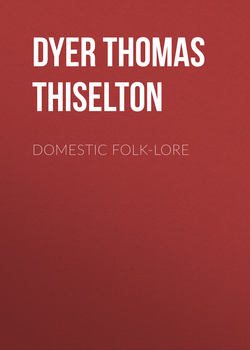Читать книгу Domestic folk-lore - Dyer Thomas Firminger Thiselton - Страница 1
ОглавлениеPREFACE
For the name "Folk-lore" in its present signification, embracing the Popular Traditions, Proverbial Sayings, Superstitions, and Customs of the people, we are in a great measure indebted to the late editor of Notes and Queries– Mr. W. J. Thoms – who, in an anonymous contribution to the Athenæum of 22nd August, 1846, very aptly suggested this comprehensive term, which has since been adopted as the recognised title of what has now become an important branch of antiquarian research.
The study of Folk-lore is year by year receiving greater attention, its object being to collect, classify, and preserve survivals of popular belief, and to trace them as far as possible to their original source. This task is no easy one, as school-boards and railways are fast sweeping away every vestige of the old beliefs and customs which, in days gone by, held such a prominent place in social and domestic life. The Folk-lorist has, also, to deal with remote periods, and to examine the history of tales and traditions which have been handed down from the distant past and have lost much of their meaning in the lapse of years. But, as a writer in the Standard has pointed out, Folk-lore students tread on no man's toes. "They take up points of history which the historian despises, and deal with monuments more intangible but infinitely more ancient than those about which Sir John Lubbock is so solicitous. They prosper and are happy on the crumbs dropped from the tables of the learned, and grow scientifically rich on the refuse which less skilful craftsmen toss aside as useless. The tales with which the nurse wiles her charge asleep provide for the Folk-lore student a succulent banquet – for he knows that there is scarcely a child's story or a vain thought that may not be traced back to the boyhood of the world, and to those primitive races from which so many polished nations have sprung."
The field of research, too, in which the Folk-lorist is engaged is a most extensive one, supplying materials for investigation of a widespread character. Thus he recognises and, as far as he possibly can, explains the smallest item of superstition wherever found, not limiting his inquiries to any one subject. This, therefore, whilst enhancing the value of Folk-lore as a study, in the same degree increases its interest, since with a perfect impartiality it lays bare superstition as it exists among all classes of society. Whilst condemning, it may be, the uneducated peasant who places credence in the village fortune-teller or "cunning man," we are apt to forget how oftentimes persons belonging to the higher classes are found consulting with equal faith some clairvoyant or spirit-medium.
Hence, however reluctant the intelligent part of the community may be to own the fact, it must be admitted that superstition, in one form or another, dwells beneath the surface of most human hearts, although it may frequently display itself in the most disguised or refined form. Among the lower orders, as a writer has observed, "it wears its old fashions, in the higher it changes with the rapidity of modes in fashionable circles." Indeed, it is no matter of surprise that superstition prevails among the poor and ignorant, when we find the affluent and enlightened in many cases quite as ready to repose their belief in the most illogical ideas.
In conclusion, we would only add that the present little volume has been written with a view of showing how this rule applies even to the daily routine of Domestic Life, every department of which, as will be seen in the following pages, has its own Folk-lore.
T. F. Thiselton Dyer.
Brighton, May, 1881.
